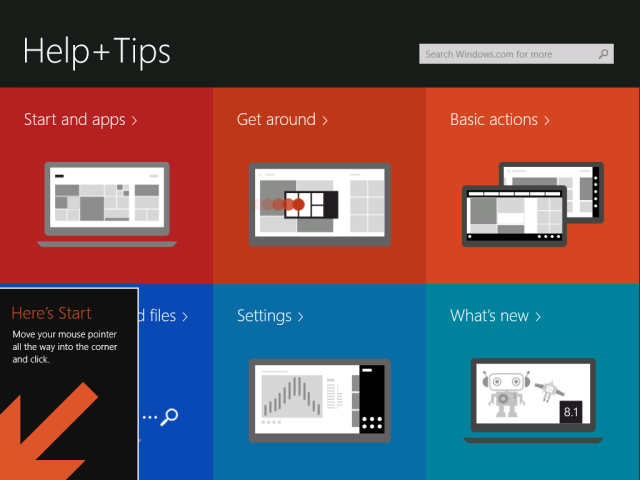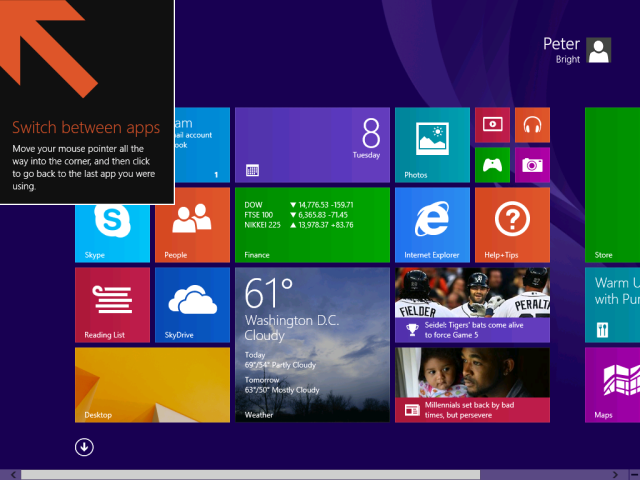Teaching the operating system
It just so happens that Windows 8.1 does a lot more on the education front than Windows 8 did.
There are two major parts to this. First, new users of the operating system will periodically see large, arguably intrusive, information panels to tell them about the corners. They appear automatically, and they provide the major details about how to use the operating system. I think they still leave the individual charms basically unexplained, unfortunately (though it might be that for whatever reason the operating system has never felt it necessary to show me more detailed info). At least when it comes to explaining the all-important bottom left corner, the panels appear to be reasonably informative.
Second, there's a new app called Help + Tips, pinned to the Start screen by default, that contains extensive advice and guidance on how to get around.

Enlarge
/
The Start tip, which just happens to be showing up over the Help app.
I can't say whether these things are actually sufficient. It's possible that new users will ignore them or just not notice them, struggling just as much as they did with Windows 8. I know my way around the system anyway, and I don't have any convenient guinea pigs to really test these things on.
Honestly, I doubt that they're perfect. They are, however, several orders of magnitude more useful and more informative than Windows 8 when it comes to showing new users the ropes. They may not be the complete solution, but there's no doubt in my mind that they're at least part of the solution. Windows 8.1 is definitely better off for their inclusion.

Enlarge
/
The tips can appear at basically any time, it seems.
It's still possible that Windows 8.2 will have to incorporate some kind of mandatory training app that runs on first use to walk new users through every step of the interface, just like Microsoft's mouse tutorials of the early 1990s.
New form factors
Windows 8 was designed for tablets with screens of about 10 inches or more. Recently, it has shipped on 8-inch tablets such as the
Acer Iconia W3
. I did not enjoy the Iconia W3 for two reasons. First, it was lumbered with an extremely poor screen (though I believe newer units have a better screen than the one I reviewed).
Second, Windows 8 just wasn't that great on a device that small. On an 8-inch screen, the desktop is basically unusable, meaning that you want to use Metro apps all the time. The Windows 8 Metro experience was incomplete in various ways, and the Metro app ecosystem was immature.
One facet of this immaturity was that even among the apps that existed, many didn't have any useful support for portrait mode. While the 10-inch tablets tend to be rather ungainly when used as portrait devices, it's an important scenario for 8-inch devices, which are much more comfortable for things like reading apps.
In 8.1, portrait orientation is more of a first-class citizen than an optional extra. Built-in apps such as Music and the Store, which didn't support portrait mode in 8.0, now have proper portrait layouts.
Adapting Windows 8.1 for these form factors has also inspired other features. The instant access to the camera from the lock screen is one such feature. Using a 10-inch tablet to take a photo serves no purpose other than to make you look foolish. Using an 8-inch tablet to take a photo is somewhat more socially acceptable.
Reading List is another small form factor-inspired app. Metro apps can send content to the Reading List for later consumption by using the share target. You can then use Reading List to return to that content and, uh, read it.
The app is simple. As with many other things in Windows 8.1, it's cloud integrated, so your actual reading list is stored on SkyDrive and shared between machines, making it a convenient repository for things you find interesting. The appeal is a little limited, however, as there are no companion apps for any other operating systems, not even Windows Phone.
The operating system that Microsoft should have shipped
There's more to Windows 8.1 than a bunch of user interface enhancements. Owners of mixed-PPI systems (for example, high-resolution laptops plugged into regular desktop screens) will welcome the new support for
multiple screen resolutions
that we looked at in June. There are new system security features, such as a standardized framework for managing fingerprint authentication, a
new system for disk encryption
, and enterprise features to help manage devices that straddle the work and home environments.
The built-in applications have received substantial updates, with
Mail, Messaging (now Skype), Calendar
, and Music and Video markedly improved over their Windows 8.0 incarnations. The SkyDrive integration is deeper and
really smart
. Internet Explorer 10 was already a solid browser with a good touch interface; Internet Explorer 11 is even better.
Looking back at the three problems with Windows 8, 8.1 improves on all of them to varying degrees. The touch interface can now reasonably be described as
complete
. It spans the full range of tasks that you'd expect to be able to do on a touch machine thanks to being more comprehensive, having full support for portrait mode, and using clever features such as the new autocomplete.
I would still like to see Microsoft do more to bring the different faces of Windows together. The
feel
is certainly improved thanks to little touches such as using the desktop wallpaper on the Start screen. But functionally, little progress has been made since Windows 8. I feel like there's a huge amount of untapped potential here and can only hope that Microsoft isn't ideologically opposed to exposing more of the Metro-side capabilities to desktop applications.
Windows 8.1 is substantially more welcoming and accommodating to new users than its predecessors. While I am concerned that it's still not enough, you can now sit someone down with Windows 8.1 and be confident that the operating system has all the information they
need
to figure out how to use the thing, as long as they're paying attention to what's written on the screen. That's progress.
The app question remains tricky. The built-in applications are much better, to the extent that they're worth using. The Store, too, is
significantly improved
, making it easier to find apps. But the apps have to exist first. Windows 8.1 introduces a bunch of new APIs for Metro apps, so in principle we should see developers do more with the platform. A rich ecosystem could yet spring into life. It's not there yet.
Windows 8.1 is a good operating system. It's imperfect and demonstrates ample room for improvement?just like any other operating system. It's also eminently usable on a day-to-day basis, whether on no-touch desktops, tablets, or hybrids. It successfully spans a range of form factors and machine types, with even broader support than its predecessor.
In many ways, I think Windows 8.1 is what Microsoft should have released instead of 8.0. With the more complete touch interface and the greater concessions to desktop users, Windows 8.1 makes Microsoft's case?that one operating system really can do it all?much more convincingly than Windows 8 did. Whatever kind of computing devices you use, Windows 8.1 will fit the needs of those devices better than Windows 8.
Windows 8 gave a glimpse of a possible future. Windows 8.1 gives us a good solid look at it. We're not there yet. But we're getting there.